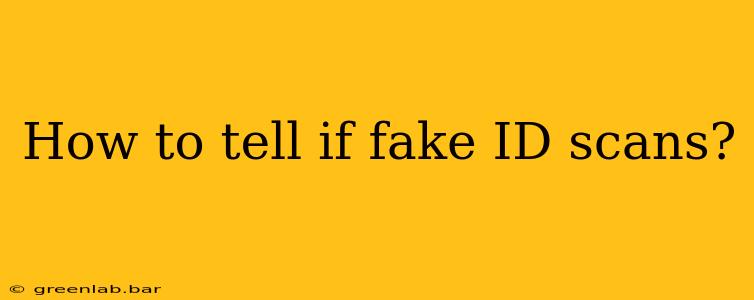Fake ID scans are becoming increasingly sophisticated, making it harder to distinguish them from genuine documents. This comprehensive guide will equip you with the knowledge and techniques to identify potential forgeries, helping you avoid scams and protect yourself from identity theft. We'll cover visual inspection, technological verification methods, and behavioral red flags.
Visual Inspection: The First Line of Defense
Before diving into technical analysis, a careful visual inspection can often reveal inconsistencies indicative of a fake ID scan. Look for these common red flags:
Obvious Signs of Manipulation:
- Blurriness or pixelation: Fake scans often lack the crisp clarity of genuine documents. Examine the image closely for unusual blurring, particularly around edges or text.
- Uneven lighting and shadows: Authentic scans usually have consistent lighting. Noticeable inconsistencies suggest potential manipulation.
- Distorted images or text: Look for any stretching, compression, or other distortions that could indicate image manipulation.
- Watermark inconsistencies: Check for watermarks – are they faded, blurry, or oddly positioned? Authentic watermarks are typically sharp and consistently placed.
- Color inconsistencies: Compare the colors in the ID scan to known examples of genuine IDs. Discrepancies in color saturation or tone could be a sign of forgery.
- Suspicious text or fonts: Examine the fonts used in the text. Are they unusual, mismatched, or of poor quality?
Subtle Clues of Fabrication:
- Unnatural alignment: Pay close attention to the alignment of images and text within the ID scan. Slight misalignments or inconsistencies can be indicative of manipulation.
- Unrealistic features: Look closely at the photograph. Does the person in the image appear too perfect or unnatural? Photoshopped images often lack subtle imperfections present in authentic photographs.
- Inconsistent serial numbers or barcodes: Carefully compare serial numbers and barcodes to known genuine examples. Inconsistencies or unusual formatting might signify a fake.
- Missing or unusual security features: Many genuine IDs feature complex security features such as holograms, microprinting, or UV reactive inks. Their absence or inconsistencies should raise suspicion.
Technological Verification: Going Beyond Visual Inspection
While visual inspection is a crucial first step, technological verification offers a more robust approach.
Reverse Image Search:
Use a reverse image search engine (like Google Images or TinEye) to check if the ID scan has appeared online elsewhere. If the scan is a fake, chances are it has been used before in fraudulent activities.
ID Verification Services:
Several services specialize in verifying the authenticity of ID scans. These services often employ sophisticated algorithms and databases to detect forgeries. (Note: We do not endorse or recommend specific services; research thoroughly before using any.)
Behavioral Red Flags: Context Matters
Context is crucial when assessing the authenticity of an ID scan. Pay attention to these behavioral red flags:
- Unusual requests for ID information: Be wary of requests for ID information outside of legitimate contexts.
- Pressure to act quickly: Legitimate organizations rarely pressure individuals to provide information immediately.
- Unclear communication: Poorly written or unclear communication can suggest a fraudulent attempt.
- Requests for sensitive information: Never provide sensitive information such as banking details or social security numbers based solely on an ID scan.
Conclusion: A Multi-Faceted Approach
Detecting fake ID scans requires a multi-faceted approach that combines visual inspection, technological verification, and an awareness of behavioral red flags. By employing these methods, you can significantly reduce your risk of falling victim to fraud and protect your personal information. Remember, when in doubt, it is always best to err on the side of caution and seek verification from a trusted source.

